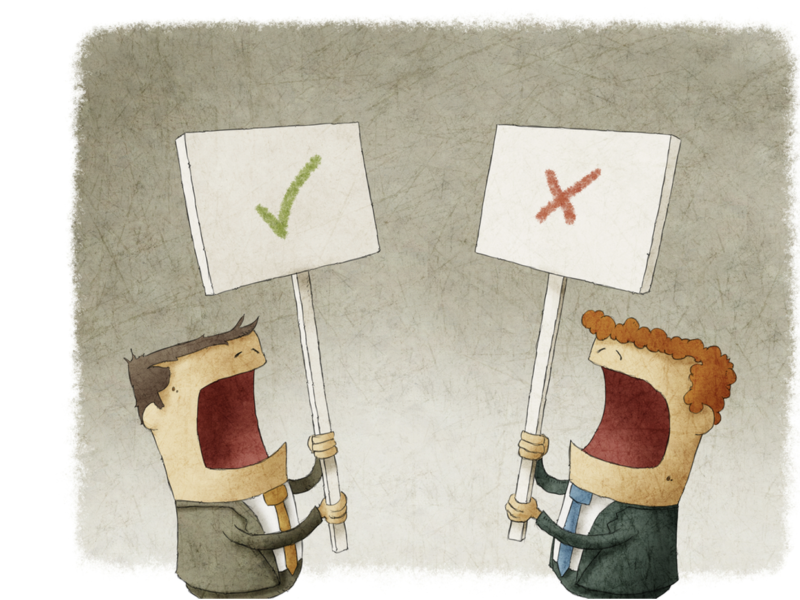Fake news is as old as humanity, maybe even older. For those trusting in the story of Adam and Eve, it started with the partial lie of the snake regarding the apple. For those trusting that the rising of a family of apes in East Africa started world dominance of humans, it might have been the misleading of other families to less fertile grounds.
From that perspective Fake News did not start with the internet or social media. What did change with the internet is that it is much easier today not just to mislead your neighbor or immediate community, but millions of people instantly with the click of a button.
How did we deal with Fake News in the past? How did we learn over time to set up control mechanisms? For the family of apes it might have been enough to sacrifice a member of the family, sending them out to the promised fertile ground and see if they would come back well nourished. Later on, cross-verification was used by sending different messenger and spies to validate information that came in. Over time it even became possible to document through remote images and sounds what was happening in other places. Velocity of cross-validation increased. But as validation mechanisms evolved, so did the technology that allowed manipulation of whole countries. One of the most prominent example could be the false flag attack on a German border post by Polish soldiers that started World War II.
What has changed? Why is this happening now? Who is driving that? …and How can we prevent the apparent success of Fake News?
What has changed?
Actually not much. Fake News and supposed facts have been divulged always with the interest of political and/or economic gains. Today it is just getting easier and easier to also manipulate content in a believable way, that was out of reach just 2 years ago.
„But I really saw a video, where he said it …“ is likely a phrase you will hear more often in the future when someone defends divulging Fake News. Deepfakes are completely manufactured videos, images and sounds – showing things that this person never said or did! Here are some Deepfake samples from back in 2020 (https://www.youtube.com/watch?v=xkqflKC64IM). Not being able to trust something (video/sound) that we were able to trust throughout our whole life, creates a sense of insecurity. But this also results in many people believing manipulated information to be true. It does not have to be a Deepfake video. In many cases videos are being produced using simple amateur or cellphone cameras, shooting videos that are enacted.
Why is this happening now?
There are many reasons. However, we should always remember: We are not living in special times. Even though it might feel to many that they are going through the most horrible situation, once put into historical perspective we are just a dot on the wall. The bubonic plague killed between 30% and 50% of the population in Europe. Wars in the Middle Ages often killed the majority of people living in a certain region, leaving nothing behind.
With prosperity increasing continuously worldwide and the redistribution of highly sought after new commodities (who needed lithium 100 years ago?) as well as the desire to control the stream of information – the complexity of human interaction increases.
Who is driving this?
This kind of information warfare is far from new. However, it becomes increasingly easier for countries to meddle in each other’s affairs. There as also organizations and individuals using these easily accessible tools to create Fake News and manufacture supposed trustworthy information.
How can we prevent the success of Fake News?
Even though it is as easy as never before to create Fake News, it has also never been easier to prevent them from being distributed. It all starts with us … the initial consumers of this information. You and I can actually prevent Fake News from being distributed – by simply not forwarding it to others and educate the people who sent it to you about how stop Fake News right in the beginning.
You are a lie detector!
„But with all this information, manipulated with high tech and advanced technology… How can I know what is true and what is a lie?“, might be your reply. We humans are actually pretty good lie detectors, as long as we listen and consume information consciously.
If you receive any kind of information that generates strong emotions in you, positive or negative, your brain is signaling you that something is off.
- Your favorite influencer tells you that „consuming this drink helped shape their body“, that „doing A or B money will flow into your account automatically or with very little effort“: Your brain is likely to get excited and in this overwhelming joy you purchase the product or even send it to your friends.
- You are receiving a message with a screenshot of someone’s Twitter publication and feel immediately the impulse to share this horrendous political view of A or B with your network: You are likely to divulge Fake News.
… And the Solution is …
In these situations of strong emotional arousel you should follow these steps:
- Stop what you are doing, breath, and wait for 30 seconds
- Search online for information about what you just saw:
- Actively search for 5 sources supporting this information
- Actively search for 5 sources NOT supporting this information
- Analyze the viability of the identified sources and imagine how either side would manipulate this kind of information
- Use common sense in deciding whether you forward information
Critical thinking and trying to put yourself into the other’s shoes have always been key in preventing the distribution of Fake News. This is not different with what we are observing today. If everyone would just apply these basic rules we would see much less Fake News and build truly strong and trusted networks with our family and friends.
Share this with your network and use this 4-step approach to stop Fake News.






